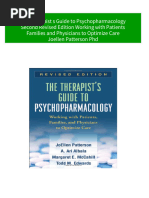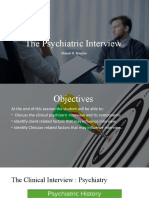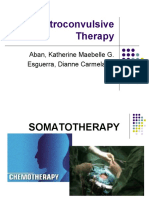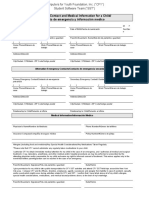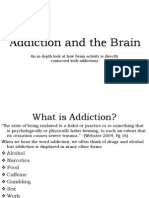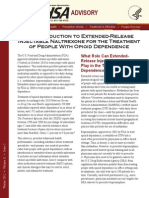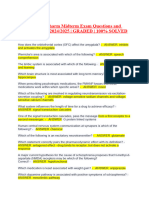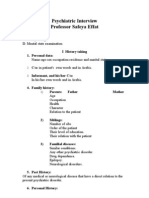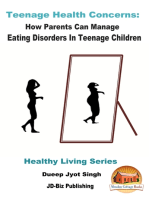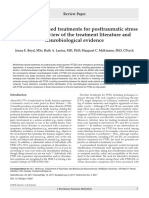Ect Leaflet
Ect Leaflet
Uploaded by
Malarvizhi Babu SandilyanCopyright:
Available Formats
Ect Leaflet
Ect Leaflet
Uploaded by
Malarvizhi Babu SandilyanOriginal Description:
Copyright
Available Formats
Share this document
Did you find this document useful?
Is this content inappropriate?
Copyright:
Available Formats
Ect Leaflet
Ect Leaflet
Uploaded by
Malarvizhi Babu SandilyanCopyright:
Available Formats
ECT information Leaflet for patients and carers
1. INTRODUCTION This leaflet is adapted from the Royal College of Psychiatrists information on ECT for patients their relatives and staff who want to know more about ECT. It discusses how ECT works, why it is used, its effects and side-effects, and alternative treatments. ECT remains a controversial treatment and some of the conflicting views about it are described. If your questions are not answered in this leaflet, there are some references and sources of further information at the end of the leaflet. Where there are areas of uncertainty, other sources of information that you can use are listed. Important concerns are the effectiveness and side-effects of ECT and how it compares with other treatments. 2. WHAT IS ECT? ECT is a treatment for a small number of severe mental illnesses. It was originally developed in the 1930s and was used widely during the 1950s and 1960s for a variety of conditions. It is now clear that ECT should only be used in a smaller number of more serious conditions. ECT consists of passing an electrical current through the brain to produce an epileptic fit hence the name, electro-convulsive. The idea developed from the observation that, in the days before there was any kind of effective medication, some people with depression or schizophrenia, and who also had epilepsy, seemed to feel better after having a fit. According to the Royal College of Psychiatrists research suggests that the effect is due to the fit rather than the electrical current. 3. HOW OFTEN IS IT USED? ECT is now used less often. Between 1985 and 2002 its use in England more than halved, possibly because of better psychological and drug treatments for depression. 6.2 Who is ECT unlikely to help? ECT is unlikely to help those with mild to moderate depression or most other psychiatric conditions. It has no role in the general treatment of schizophrenia. 6.3 Why is it given when there are other treatments available? It would normally be offered if: several different medications have been tried but have not helped the side-effects of antidepressants are too severe you have found ECT helpful in the past your life is in danger because you are not eating or drinking enough you are trying to kill yourself 6.4. What are the side effects of ECT? ECT is a major procedure involving, over a few weeks, several epileptic seizures and several anaesthetics. It is used for people with severe illness who are very unwell and whose life may be in danger. As with any treatment, ECT can cause a number of side-effects. some of these are mild and some are more severe. Short-term Many people complain of a headache immediately after ECT and of aching in their muscles. They may feel muzzy-headed and generally out of sorts, or even a bit sick
You might also like
- Buy Ebook The American Psychiatric Association Publishing Textbook of Geriatric Psychiatry 6th Edition Not True PDF David C. Steffens Cheap PriceDocument75 pagesBuy Ebook The American Psychiatric Association Publishing Textbook of Geriatric Psychiatry 6th Edition Not True PDF David C. Steffens Cheap Pricedorfemprez100% (3)
- Ebooks File The Therapist S Guide To Psychopharmacology Second Revised Edition Working With Patients Families and Physicians To Optimize Care Joellen Patterson PHD All ChaptersDocument84 pagesEbooks File The Therapist S Guide To Psychopharmacology Second Revised Edition Working With Patients Families and Physicians To Optimize Care Joellen Patterson PHD All Chaptersulfecarti100% (14)
- Adult Case MGT Training Manual 2019Document44 pagesAdult Case MGT Training Manual 2019Tracy Ables-TatroNo ratings yet
- MH Exam 2 Study GuideDocument24 pagesMH Exam 2 Study Guidewn4tb100% (1)
- Psychosocial Assessment REVISED2 CMDocument6 pagesPsychosocial Assessment REVISED2 CMAlfunnafi' Fahrul RizzalNo ratings yet
- George Bipolar Disorder Case StudyDocument9 pagesGeorge Bipolar Disorder Case StudyCaimito StreetNo ratings yet
- 4th Module-Counselling Strategies and InterventionsDocument16 pages4th Module-Counselling Strategies and InterventionsVijesh V Kumar100% (1)
- Conduct DisorderDocument14 pagesConduct Disorderima100% (2)
- Drug Card TemplateDocument1 pageDrug Card TemplateBonibel Bee ParkerNo ratings yet
- Final Period - Assignment NCM 105Document3 pagesFinal Period - Assignment NCM 105Chester NicoleNo ratings yet
- Soap Note - DDocument2 pagesSoap Note - Dapi-263972200No ratings yet
- Psychiatry For Medical Students and ResidentsDocument80 pagesPsychiatry For Medical Students and ResidentsNabeel Kouka, MD, DO, MBA, MPH100% (4)
- Brief Psychiatric Rating Scale (BPRS) : Expanded VersionDocument29 pagesBrief Psychiatric Rating Scale (BPRS) : Expanded VersionNungki TriandariNo ratings yet
- Psychodynamic Psychotherapy For Social PhobiaDocument29 pagesPsychodynamic Psychotherapy For Social Phobiajuaromer50% (2)
- Evaluation of The Use of A Sensory Room On An AdolescentDocument8 pagesEvaluation of The Use of A Sensory Room On An AdolescentKaylee OmanNo ratings yet
- Paranoid SchizophreniaDocument3 pagesParanoid Schizophreniabuen guisalaNo ratings yet
- Invega+Sustenna PiDocument18 pagesInvega+Sustenna PiMaal AbrarNo ratings yet
- PSYCH - PsychosomaticdelasalleDocument58 pagesPSYCH - Psychosomaticdelasalleapi-3856051100% (1)
- The Psychiatric InterviewDocument34 pagesThe Psychiatric InterviewPinkRose BrownSpiceNo ratings yet
- Addiction PsychiatryDocument10 pagesAddiction PsychiatryshafijanNo ratings yet
- PA 644 - M2 LecturesDocument735 pagesPA 644 - M2 LectureskatNo ratings yet
- Introduction To Psychiatric Nursing: Mercedes A Perez-Millan MSN, ARNPDocument33 pagesIntroduction To Psychiatric Nursing: Mercedes A Perez-Millan MSN, ARNPSachiko Yosores100% (1)
- Depression in Older AdultsDocument9 pagesDepression in Older Adultsapi-509881562No ratings yet
- 2017 - Behavioral Emergencies - Geriatric Psychiatric PatientDocument14 pages2017 - Behavioral Emergencies - Geriatric Psychiatric PatientAna María Arenas DávilaNo ratings yet
- Electroconvulsive Therapy: Aban, Katherine Maebelle G. Esguerra, Dianne Carmela RDocument46 pagesElectroconvulsive Therapy: Aban, Katherine Maebelle G. Esguerra, Dianne Carmela REdgar ManoodNo ratings yet
- 00 Psycho ListDocument13 pages00 Psycho ListUrsea MandyNo ratings yet
- Antidepressant and Antipsychotic Side-Effects and Personalised Prescribing, A Systematic Review and Digital Tool Development. Lancet 2023Document17 pagesAntidepressant and Antipsychotic Side-Effects and Personalised Prescribing, A Systematic Review and Digital Tool Development. Lancet 2023tomil.hoNo ratings yet
- SST Emergency-Medical Consent Form (SPANISH RMM)Document2 pagesSST Emergency-Medical Consent Form (SPANISH RMM)flonoelNo ratings yet
- Carlat, Daniel J. - The Psychiatric Interview-Wolters Kluwer (2017) Cap 1 A 6. Páginas 20 - 54Document35 pagesCarlat, Daniel J. - The Psychiatric Interview-Wolters Kluwer (2017) Cap 1 A 6. Páginas 20 - 54Juan PabloNo ratings yet
- Joshua Dodot Case StudyDocument2 pagesJoshua Dodot Case StudyJoshua Ringor100% (1)
- Tourette's SyndromeDocument31 pagesTourette's SyndromeGhadeer AlomariNo ratings yet
- Psychiatry Notes - Depressive DisorderDocument2 pagesPsychiatry Notes - Depressive DisorderLiSenNo ratings yet
- Psychiatry Case LogDocument6 pagesPsychiatry Case Logf3er3No ratings yet
- Adictia Si CreierulDocument13 pagesAdictia Si CreierulMihaelaSiVictoria100% (1)
- DFS Gender Dysphoria LetterDocument3 pagesDFS Gender Dysphoria LetterMatthew HamiltonNo ratings yet
- Danielle Mcminn Case Study 1Document10 pagesDanielle Mcminn Case Study 1api-401807507No ratings yet
- Schizophrenia TreatmentDocument6 pagesSchizophrenia TreatmentMichNo ratings yet
- PMHNP Case Study - EditedDocument7 pagesPMHNP Case Study - EditedSoumyadeep BoseNo ratings yet
- Type 1 Diabetes Mellitus Clinical Presentation - History, Physical Examination, ComplicationsDocument6 pagesType 1 Diabetes Mellitus Clinical Presentation - History, Physical Examination, ComplicationsTrifosa Ika Septiana EryaniNo ratings yet
- Murtagh DEPRESSION PsychoeducationDocument1 pageMurtagh DEPRESSION PsychoeducationWaoNo ratings yet
- Sleep Disorders in Children and Adolescents: Deepti Shenoi MDDocument50 pagesSleep Disorders in Children and Adolescents: Deepti Shenoi MDCitra Sukri Sugesti100% (1)
- Postpartum Depression in MenDocument4 pagesPostpartum Depression in MenMustafa BayramNo ratings yet
- Perinatal+Anxiety+and+Depressive+Disorders PPG v3.0Document13 pagesPerinatal+Anxiety+and+Depressive+Disorders PPG v3.0tanmai nooluNo ratings yet
- Comorbidity GuidelineDocument589 pagesComorbidity Guidelineعمر الحدادNo ratings yet
- Vivitrol TreatmentDocument8 pagesVivitrol TreatmentHarish RathodNo ratings yet
- Off-Label Trazodone Prescription-Evidence, Benefits and RisksDocument9 pagesOff-Label Trazodone Prescription-Evidence, Benefits and RisksomarapesNo ratings yet
- Final Capstone PaperDocument15 pagesFinal Capstone Paperapi-478784238No ratings yet
- Seminar On Obsessive Compulsive DisorderDocument41 pagesSeminar On Obsessive Compulsive Disordersushmitabiswas052100% (1)
- Treatment Resistant OCD .Document55 pagesTreatment Resistant OCD .Dr viren SolankiNo ratings yet
- Social Psychiatry Principles and Clinical Perspectives 1nbsped 9789354651021 9789352704224 CompressDocument557 pagesSocial Psychiatry Principles and Clinical Perspectives 1nbsped 9789354651021 9789352704224 CompressTom JaipurkarNo ratings yet
- Study Guide Test 1Document11 pagesStudy Guide Test 1jwasylow13No ratings yet
- MSE DVD Booklet - Oct 2011Document21 pagesMSE DVD Booklet - Oct 2011Daniela Ramos100% (1)
- A Bio Psychosocial Spiritual Assessment Guide For Health and Social WorkDocument38 pagesA Bio Psychosocial Spiritual Assessment Guide For Health and Social WorkNabil Shaleh100% (1)
- TrichotillamaniaDocument10 pagesTrichotillamaniaTaraNo ratings yet
- Pediatrics: St. Elizabeth Family Medicine Residency ProgramDocument9 pagesPediatrics: St. Elizabeth Family Medicine Residency Programwingchun108tekNo ratings yet
- The RX Files: QT Prolongation and Torsades de Pointes: Drugs and Sudden DeathDocument2 pagesThe RX Files: QT Prolongation and Torsades de Pointes: Drugs and Sudden DeathRahul RaiNo ratings yet
- B /G C U I R: Anti-PsychoticsDocument2 pagesB /G C U I R: Anti-PsychoticsErsy Sakti ilhamNo ratings yet
- Review of The Worldwide Epidemiology of Eating DisordersDocument4 pagesReview of The Worldwide Epidemiology of Eating DisordersInês RodriguesNo ratings yet
- NR546 Psychopharm Midterm Exam Questions and Answers Latest 2021Document11 pagesNR546 Psychopharm Midterm Exam Questions and Answers Latest 2021iannyaga450No ratings yet
- Substance Abuse & Mental HealthDocument1 pageSubstance Abuse & Mental Healthkaitlin100% (1)
- Psychiatric Interview Professor Safeya Effat: I History Taking 1. Personal DataDocument4 pagesPsychiatric Interview Professor Safeya Effat: I History Taking 1. Personal DataAcha Angel BebexzNo ratings yet
- Specific Phobia: Causes and Perspectives.: Presented by Susmitha RDocument19 pagesSpecific Phobia: Causes and Perspectives.: Presented by Susmitha RSusmiNo ratings yet
- Paranoid Schizophrenia Mayo ClinicDocument20 pagesParanoid Schizophrenia Mayo Cliniceinjehl160305No ratings yet
- Teenage Health Concerns: How Parents Can Manage Eating Disorders In Teenage ChildrenFrom EverandTeenage Health Concerns: How Parents Can Manage Eating Disorders In Teenage ChildrenNo ratings yet
- Integrative Dual Diagnosis Treatment Approach to an Individual with Alcoholism and Coexisting Endogenous DepressionFrom EverandIntegrative Dual Diagnosis Treatment Approach to an Individual with Alcoholism and Coexisting Endogenous DepressionRating: 2 out of 5 stars2/5 (1)
- Christian, Miles 504 2020-2021Document5 pagesChristian, Miles 504 2020-2021dehof46162No ratings yet
- Sleep Apnea PDFDocument257 pagesSleep Apnea PDFdantevermillion100% (6)
- SuicideDocument15 pagesSuicideamal100% (1)
- CPLOL, ProfesiuneaDocument4 pagesCPLOL, ProfesiuneananuflorinaNo ratings yet
- PTSD TreatmentDocument2 pagesPTSD TreatmentAlesha Rose100% (1)
- 2016 Psychaitric Nursing Problem StatementsDocument10 pages2016 Psychaitric Nursing Problem StatementsMAHESH KOUJALAGI100% (1)
- Unit 3 Abnormal PsychologyDocument12 pagesUnit 3 Abnormal PsychologyMohammed SaniNo ratings yet
- Elena Vanishing Discussion GuideDocument4 pagesElena Vanishing Discussion GuideChronicleBooksNo ratings yet
- Psychiatry OSCE HistoriesDocument5 pagesPsychiatry OSCE HistoriesrangaNo ratings yet
- Obsessive-Compulsive and Related DisordersDocument23 pagesObsessive-Compulsive and Related DisordersbastudeNo ratings yet
- Facil Powerpoint: FinalDocument32 pagesFacil Powerpoint: FinalWilbur CatianNo ratings yet
- CPE 4611 Assessment and Diagnosis of Mental Disorder: Transvestic Disorder 302.3 (F65.1) PG 702 DSM 5Document21 pagesCPE 4611 Assessment and Diagnosis of Mental Disorder: Transvestic Disorder 302.3 (F65.1) PG 702 DSM 5Hafiz HazimiNo ratings yet
- Utility of The Modified Mini Screen (MMS) For Screening Mental HeDocument96 pagesUtility of The Modified Mini Screen (MMS) For Screening Mental Hevaradh24No ratings yet
- MCQsDocument95 pagesMCQsMarcus GrisomNo ratings yet
- DSM 5 - Motor DisorderDocument5 pagesDSM 5 - Motor DisorderjackyploesNo ratings yet
- Research ProposalDocument14 pagesResearch Proposalapi-284446774No ratings yet
- Mindfulness and PTSDDocument19 pagesMindfulness and PTSDJosie VuckovichNo ratings yet
- 3 Sided Essay FinalDocument3 pages3 Sided Essay FinalDominique TaylorNo ratings yet
- The Flight of The MindDocument285 pagesThe Flight of The Mindmusic2850No ratings yet
- Mental Status ExamDocument2 pagesMental Status ExamNur Atiqah Mohd AzliNo ratings yet
- Risk Factos and Causes of Emotional and BehavioralDocument22 pagesRisk Factos and Causes of Emotional and BehavioralTrisha Mae LlagasNo ratings yet
- Afasia Primaria Progresiva y Apraxia Del Habla Continuum 2019Document27 pagesAfasia Primaria Progresiva y Apraxia Del Habla Continuum 2019Habib G. Moutran BarrosoNo ratings yet
- Schizophrenia 2.2Document5 pagesSchizophrenia 2.2Sheila Cruz RodriguezNo ratings yet

